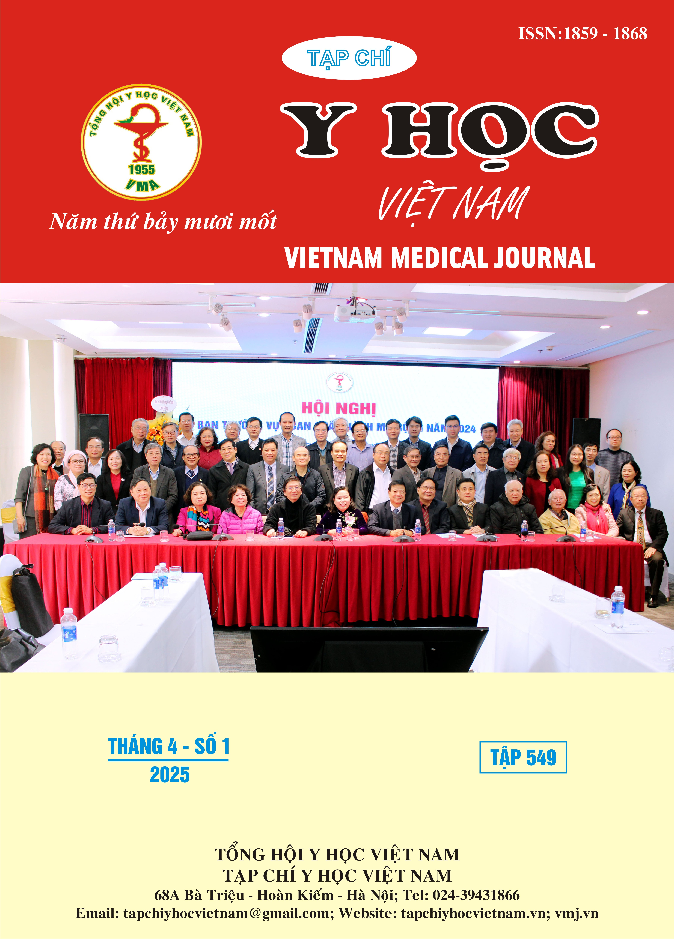SURGICAL OUTCOMES OF PRIMARY RETROPERITONEAL TUMORS AT VIET DUC UNIVERSITY HOSPITAL
Main Article Content
Abstract
Background: Surgical resection remains the most effective treatment for retroperitoneal tumors. However, these tumors are often diagnosed at an advanced stage, with a large tumor size, deep retroperitoneal location, and involvement of critical structures. Consequently, the rate of complete resection remains low, and postoperative complication rates are still high. This study aimed to evaluate the outcomes of surgical treatment for retroperitoneal tumors at Viet Duc University Hospital. Methods: A retrospective study was conducted on 72 patients with primary retroperitoneal tumors, who underwent surgical resection at Viet Duc University Hospital from January 2017 to December 2022. Results: A total of 72 patients were included (23 males, 31.9%; 49 females, 68.1%). The mean age was 45.9±14.9 years. Fifty-five patients underwent open surgery, while 17 patients underwent laparoscopic surgery, including 5 patients who required conversion to open surgery. Complete tumor resection was achieved in 67 patients (93.1%), whereas 4 patients (5.6%) underwent partial resection, and 1 patient (1.4%) had only a biopsy. Pathological results showed 49 benign tumors (68.1%) and 23 malignant tumors (31.9%). The rate of adjacent organ resection was 27.8%. The overall postoperative complication rate was 11.1%, with no postoperative mortality. The average operation time for malignant tumors was 149.9±54.7 minutes, while it was 132.7±69.4 minutes for benign tumors. The average hospital stay was 7.9±3.5 days. During follow-up, 13.6% of patients experienced tumor recurrence, with an average time to recurrence of 10.5±2.2 months. The survival rates for malignant tumors at 1, 3, and 5 years were 86.4%, 74.8%, and 66.5%, respectively. Conclusion: Surgical resection remains the most effective treatment for retroperitoneal tumors, achieving a high rate of complete tumor resection, low intraoperative and postoperative complication rates, and no postoperative mortality. It also improved survival, with a 5-year survival rate of 66.5% for malignant tumors.
Article Details
Keywords
primary retroperitoneal tumor, surgical outcomes
References
2. Strauss, D.C., et al., Surgical management of primary retroperitoneal sarcoma. Br J Surg, 2010. 97(5): p. 698-706.
3. Bansal, A., et al., WHO classification of soft tissue tumours 2020: An update and simplified approach for radiologists. Eur J Radiol, 2021. 143: p. 109937.
4. Neville, A. and B.R. Herts, CT characteristics of primary retroperitoneal neoplasms. Crit Rev Comput Tomogr, 2004. 45(4): p. 247-70.
5. Kaganov, O.I., et al., Single-Center Experience of Surgical Treatment of Primary Retroperitoneal Tumors. Indian J Surg Oncol, 2020. 11(3): p. 412-417.
6. Sassa, N., et al., Clinical characteristics and surgical outcomes of retroperitoneal tumors: a comprehensive data collection from multiple departments. Int J Clin Oncol, 2020. 25(5): p. 929-936.
7. Vũ, T.A., Chẩn đoán và điều trị phẫu thuật bướu sau phúc mạc tại Bệnh viện Chợ Rẫy. Tạp chí Y học TP. Hồ Chí Minh, 2016. 20: p. 56-61.
8. Munoz, P., et al., Surgical Principles of Primary Retroperitoneal Sarcoma in the Era of Personalized Treatment: A Review of the Frontline Extended Surgery. Cancers (Basel), 2022. 14(17).
9. Ji, X.K., et al., Diagnosis and surgical treatment of retroperitoneal paraganglioma: A single-institution experience of 34 cases. Oncol Lett, 2017. 14(2): p. 2268-2280.
10. Tấn, H.D., U sau phúc mạc: Đặc điểm bệnh lý, kết quả phẫu thuật. Tạp chí Y học TP. Hồ Chí Minh, 2018. 22: p. 146-152.


